The Interconnecting Process and Sensing Performance of Stretchable Hybrid Electronic Yarn for Body Temperature Monitoring
Abstract
:1. Introduction
2. Material and Experiment
2.1. Structure Design of HETS Yarn
2.2. Materials
2.3. Stretchable HETS Yarn Preparation
2.3.1. Interconnection Process
Bonding with Conductive Copper Adhesive
Soldering with a Lead-Free Tin Wire
Soldering with a Lead-Free Tin Paste
2.3.2. Encapsulation Process
2.3.3. Test and Evaluation
- (1)
- Surface morphology
- (2)
- Electrical resistance variation
- (3)
- Sensitivity
- (4)
- Bending fatigue
- (5)
- Encapsulation effect
3. Results and Discussion
3.1. Temperature–Resistance Response of Hybrid Electronic Yarn
3.2. Sensing Performance of HETS Yarn
- (1)
- Sensitivity
- (2)
- Hysteresis
- (3)
- Response time
- (4)
- Bending fatigue
4. Encapsulation Effect
4.1. Surface Morphology
4.2. Sensing Property of HETS Yarn with Encapsulation
5. Conclusions
Author Contributions
Funding
Institutional Review Board Statement
Data Availability Statement
Conflicts of Interest
References
- Lee, Y.H.; Kweon, O.Y.; Kim, H.; Yoo, J.H.; Han, S.G.; Oh, J.H. Recent advances in organic sensors for health self-monitoring systems. J. Mater. Chem. C 2018, 6, 8569–8612. [Google Scholar] [CrossRef]
- Ogoina, D. Fever, fever patterns and diseases called ‘fever’—A review. J. Infect. Public Health 2011, 4, 108–124. [Google Scholar] [CrossRef] [PubMed]
- Li, Q.; Zhang, L.N.; Tao, X.M.; Ding, X. Review of flexible temperature sensing networks for wearable physiological monitoring. Adv. Healthc. Mater. 2017, 6, 1601371. [Google Scholar] [CrossRef] [PubMed]
- Fang, Y.S.; Chen, G.R.; Bick, M.; Chen, J. Smart textiles for personalized thermo-regulation. Chem. Soc. Rev. 2021, 50, 9357–9374. [Google Scholar] [CrossRef] [PubMed]
- Wang, H.Y.; Meng, F.Y.; Hu, J.Y.; Yang, X.D. Review on temperature sensing yarns for smart textiles. J. Silk 2022, 59, 54–63. [Google Scholar]
- Lee, J.; Kim, D.W.; Chun, S.; Song, J.H.; Yoo, E.S. Intrinsically strain-insensitive, hyperelastic temperature-sensing fiber with compressed micro-wrinkles for integrated textronics. Adv. Mater. Technol. 2020, 5, 2000073. [Google Scholar] [CrossRef]
- Hughes-Riley, T.; Lugoda, P.; Dias, T.; Trabi, C.L.; Morris, R.H. A study of thermistor performance within a textile structure. Sensors 2017, 17, 1804. [Google Scholar] [CrossRef]
- Li, M.L.; Tudor, J.; Liu, J.Q.; Torah, R.; Komolafe, A.; Beeby, S. Novel electronic packaging method for functional electronic textiles. IEEE Trans. Compon. Packag. Manuf. Technol. 2019, 9, 216–225. [Google Scholar] [CrossRef]
- Simegnaw, A.A.; Malengier, B.; Tadesse, M.G.; Van Langenhove, L. Development of stainless steel yarn with embedded surface mounted light emitting diodes. Materials 2022, 15, 2892. [Google Scholar] [CrossRef]
- Lugoda, P.; Costa, J.C.; Oliveira, C.; Garcia-Garcia, L.A.; Wickramasinghe, S.D.; Pouryazdan, A. Flexible temperature sensor integration into E-textiles using different industrial yarn fabrication processes. Sensors 2020, 20, 73. [Google Scholar] [CrossRef]
- Tao, X.; Liu, S.; Yang, B.; Zhang, L.S.; Ma, K.M.; Shu, L. Recent advances, scientific issues, key technologies and perspective of textile electronics. Chin. Sci. Bull. 2021, 66, 3071–3087. [Google Scholar] [CrossRef]
- Hughes-Riley, T.; Jobling, P.; Dias, T.; Faulkner, S.H. An investigation of temperature-sensing textiles for temperature monitoring during submaximal cycling trials. Text. Res. J. 2021, 91, 624–645. [Google Scholar] [CrossRef]
- Zhang, Y.; Meng, F.Y.; Hu, J.Y.; Yang, X.D. Physical relationship between resonant frequency and structure parameters of a normal mode helix dipole antenna for an ultra-high frequency radio frequency identification tag thread. Text. Res. J. 2022, 92, 4576–4586. [Google Scholar] [CrossRef]
- Li, Q.; Si, M.Z.; Liu, T.T.; Luo, Q.Q.; Zhang, T.S.; Wang, X. Stretchable conductive yarn with extreme electrical stability pushes fabrication of versatile textile stretchable electronics. Compos. Commun. 2022, 31, 101131. [Google Scholar] [CrossRef]
- Shekhar, R.; Choudhry, N.A.; Islam, S.; Ahnood, A.; Pirogova, E.; Troynikov, O. A novel elastic conductive yarn for smart textile applications. Adv. Eng. Mater. 2023, 25, 2300572. [Google Scholar] [CrossRef]
- Meng, F.Y.; Hu, J.Y. Effect of flip chip bonding parameters on the property of passive UHF RFID tags with screen-printed antenna on fabric. Text. Res. J. 2023, 93, 3642–3655. [Google Scholar] [CrossRef]
- Aradhana, R.; Mohanty, S.; Nayak, S.K. A review on epoxy-based electrically conductive adhesives. Int. J. Adhes. Adhes. 2020, 99, 102596. [Google Scholar] [CrossRef]
- Zhang, Q.; Peng, F.; Hu, J.Y.; Yang, X.D. Machine washing endurance and coating of UHF-RFID tags based on screen-printed antenna on fabric. J. Donghua Univ. (Nat. Sci.) 2021, 47, 60–67. [Google Scholar]
- Simegnaw, A.A.; Malengier, B.; Getnet, M.; Van-Langenhove, L. Connecting surface-mounted electronic elements with amber strand metal-clad conductive fibers by reflow soldering. Text. Res. J. 2023, 93, 4068. [Google Scholar] [CrossRef]
- Ojuroye, O.; Torah, R.; Beeby, S. Modified PDMS packaging of sensory e-textile circuit microsystems for improved robustness with washing. Microsyst. Technol. 2022, 28, 1467–1484. [Google Scholar] [CrossRef]
- Kuzubasoglu, B.A.; Sayar, E.; Cochrane, C.; Koncar, V.; Bahadir, S. Wearable temperature sensor for human body temperature detection. J. Mater. Sci. Mater. Electron. 2021, 32, 4784–4797. [Google Scholar] [CrossRef]
- Gu, Y.M.; Li, Y.M.; Shaw, A. Development and performance of flexible temperature-sensing fabric. J. Text. Inst. 2021, 113, 2770–2777. [Google Scholar] [CrossRef]
- Lu, L.; Feng, J.; Lu, X. Thermal response time constant and the measurement method for temperature sensor. Instrum. Tech. Sens. 2005, 7, 17–18. [Google Scholar] [CrossRef]



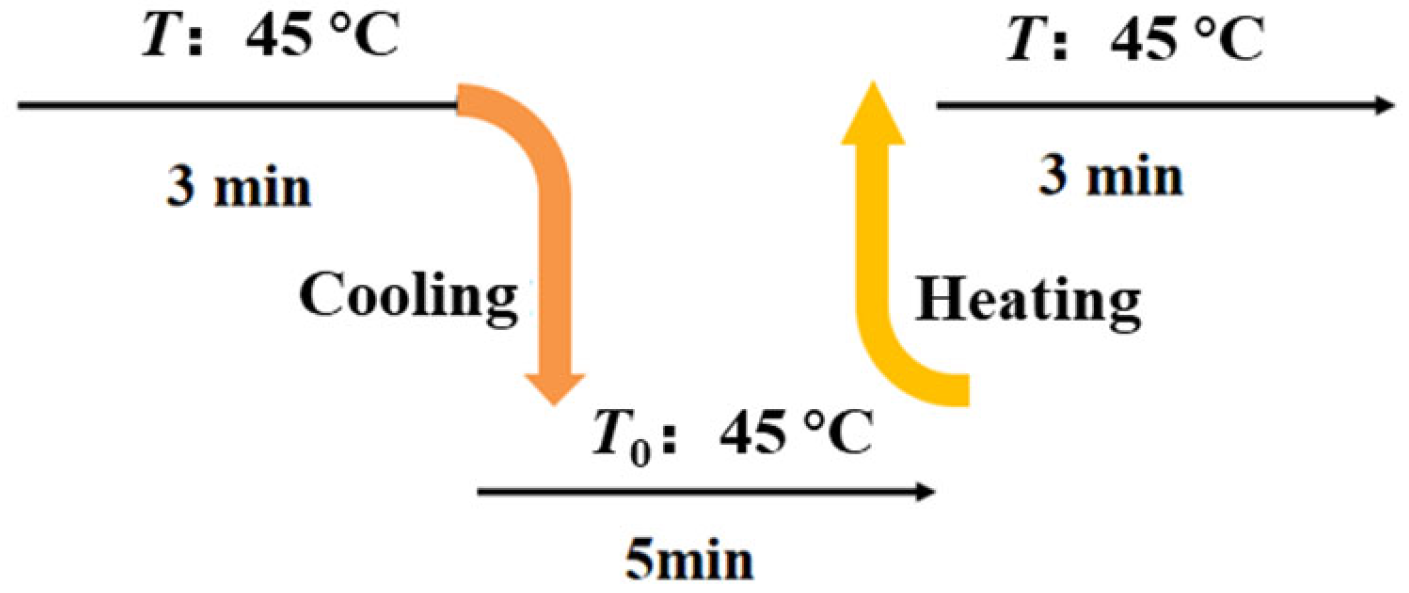
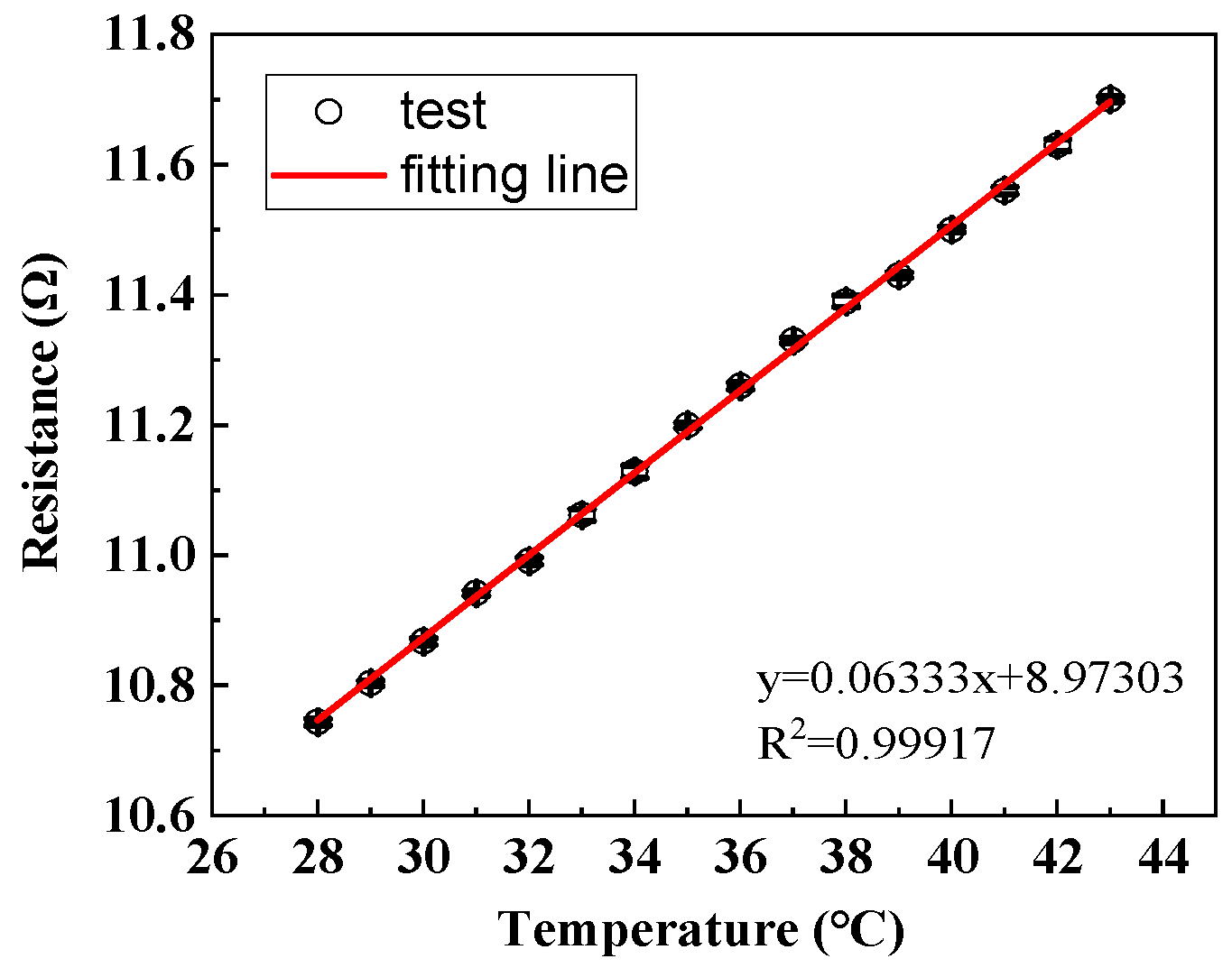
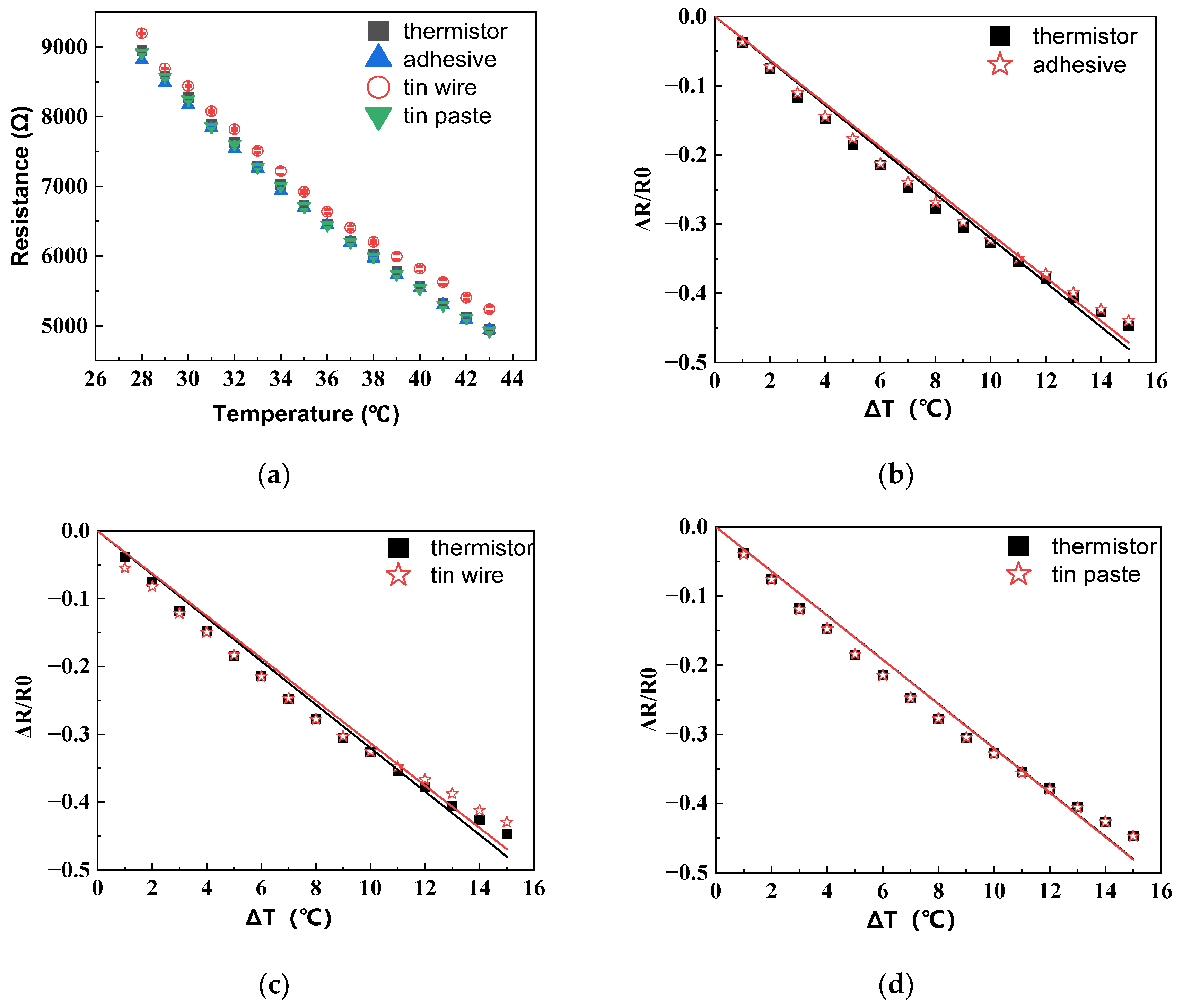
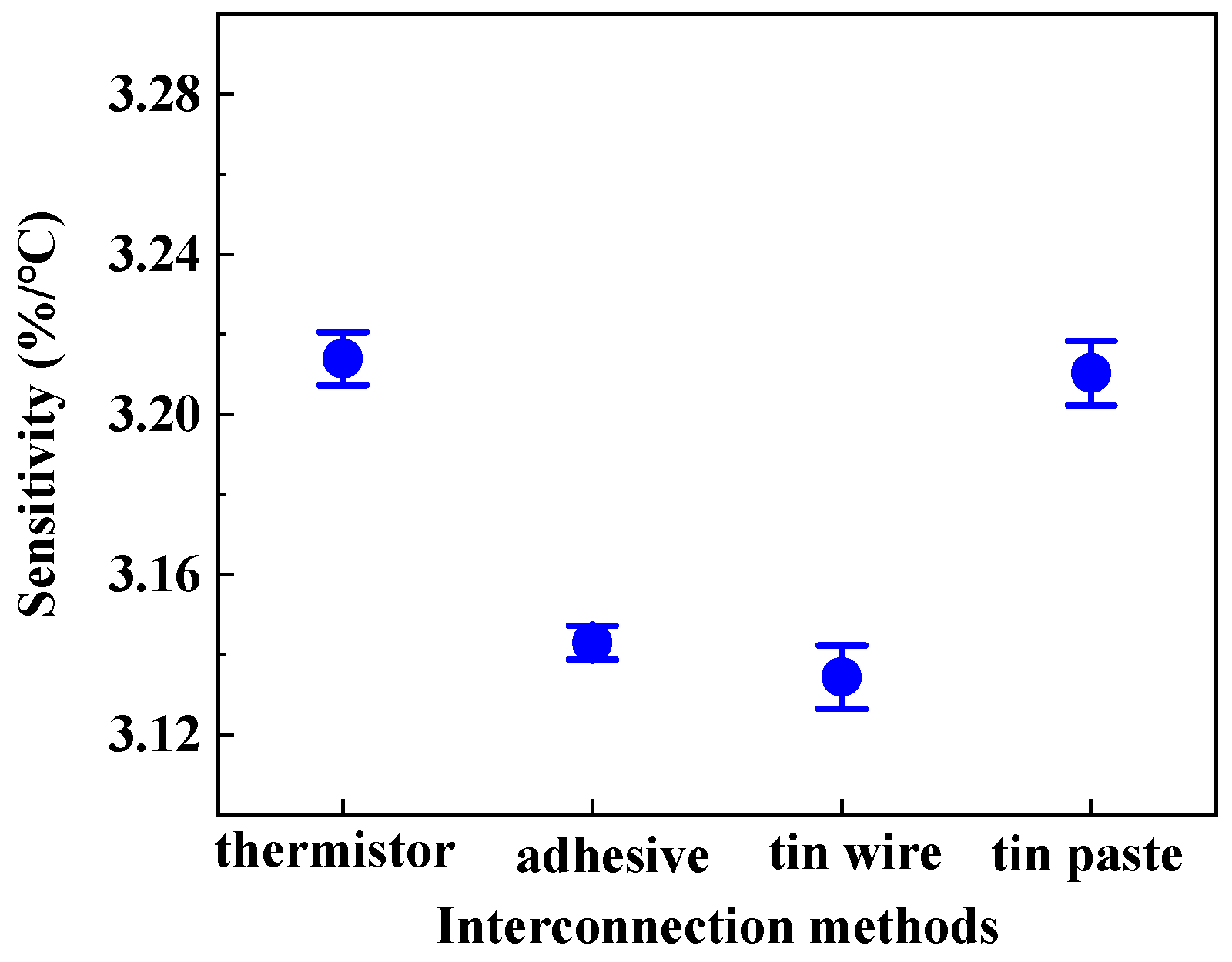


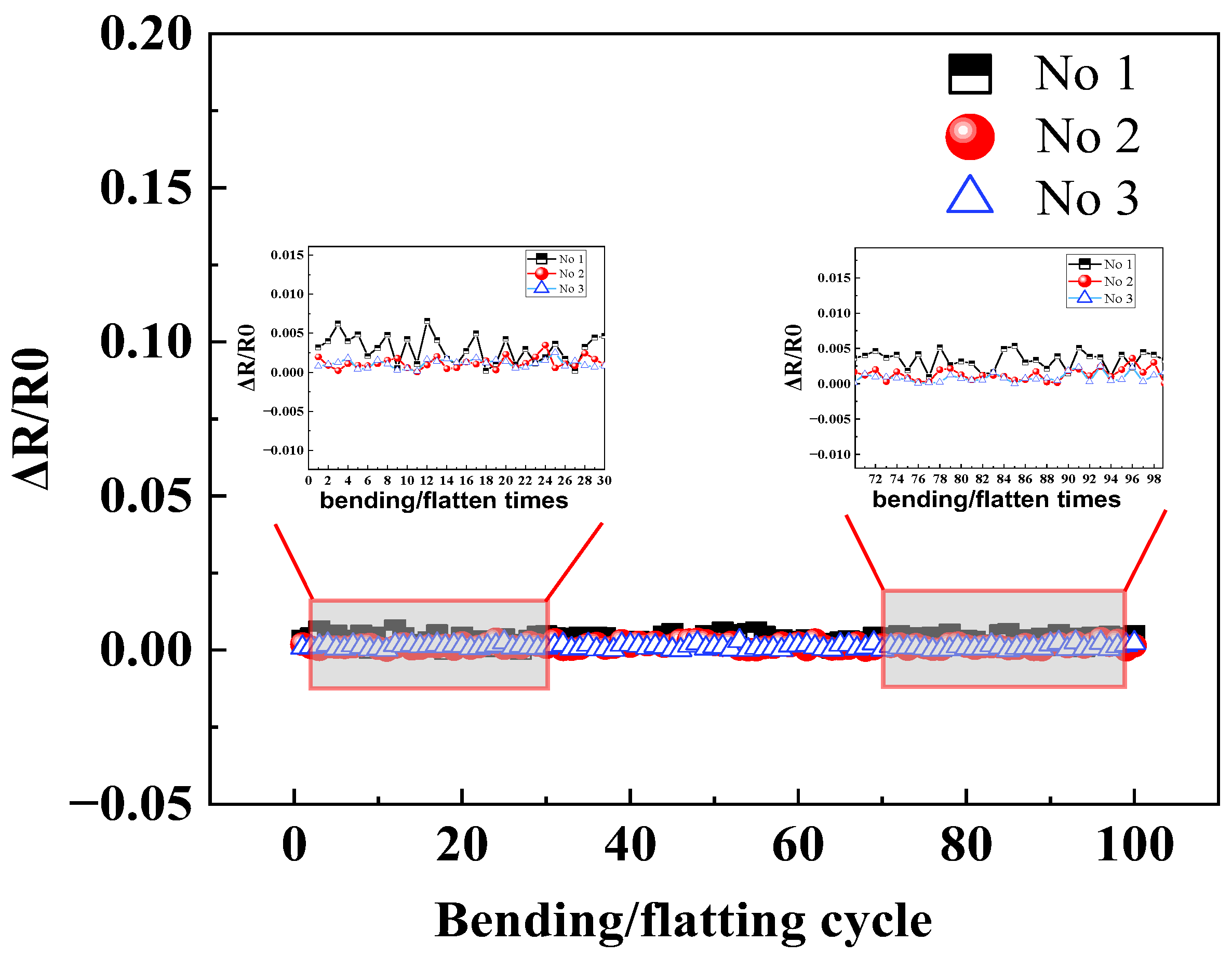
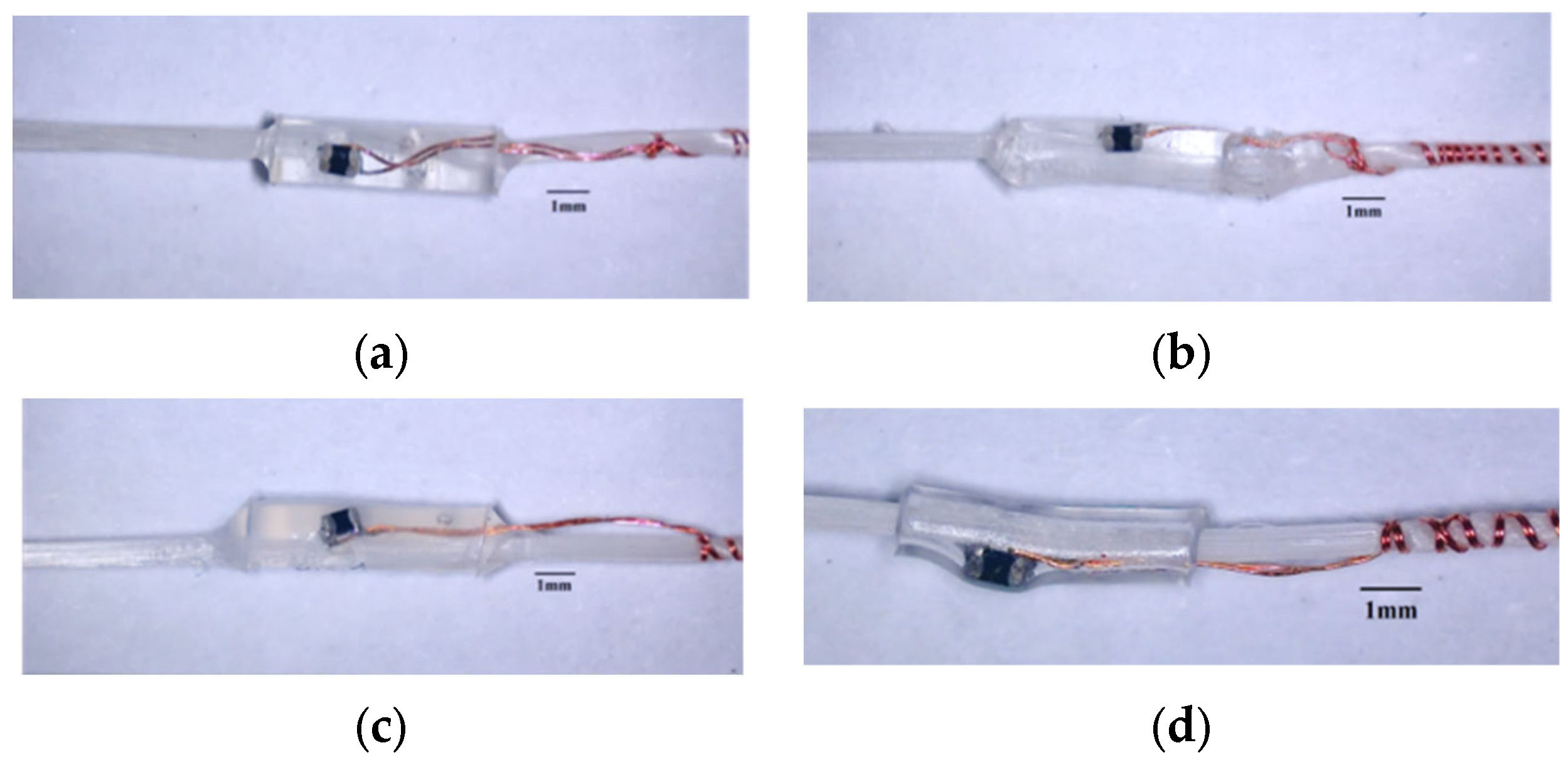

| Interconnection Method | Response Time (s) | |
|---|---|---|
| Cooling | Heating | |
| Adhesive bonding | 2.78 ± 0.28 | 2.13 ± 0.34 |
| Tin wire | 3.20 ± 0.50 | 1.86 ± 0.19 |
| Tin paste | 3.64 ± 0.48 | 2.31 ± 0.33 |
Disclaimer/Publisher’s Note: The statements, opinions and data contained in all publications are solely those of the individual author(s) and contributor(s) and not of MDPI and/or the editor(s). MDPI and/or the editor(s) disclaim responsibility for any injury to people or property resulting from any ideas, methods, instructions or products referred to in the content. |
© 2024 by the authors. Licensee MDPI, Basel, Switzerland. This article is an open access article distributed under the terms and conditions of the Creative Commons Attribution (CC BY) license (https://creativecommons.org/licenses/by/4.0/).
Share and Cite
Meng, F.; Dai, S.; Zhang, Y.; Hu, J. The Interconnecting Process and Sensing Performance of Stretchable Hybrid Electronic Yarn for Body Temperature Monitoring. Polymers 2024, 16, 243. https://doi.org/10.3390/polym16020243
Meng F, Dai S, Zhang Y, Hu J. The Interconnecting Process and Sensing Performance of Stretchable Hybrid Electronic Yarn for Body Temperature Monitoring. Polymers. 2024; 16(2):243. https://doi.org/10.3390/polym16020243
Chicago/Turabian StyleMeng, Fenye, Shaoqing Dai, Yong Zhang, and Jiyong Hu. 2024. "The Interconnecting Process and Sensing Performance of Stretchable Hybrid Electronic Yarn for Body Temperature Monitoring" Polymers 16, no. 2: 243. https://doi.org/10.3390/polym16020243





